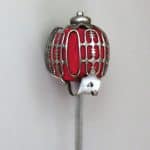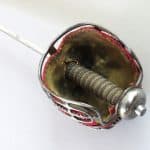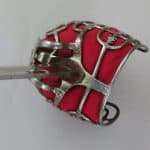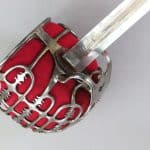
A Very Fine Scottish “Pinch of Snuff” Basket Hilted Sword
To enquire about this itemplease click here
Price: £9,500
Ref: 42701128
Item Description
An attractive Scottish Officer’s basket hilted sword dating to the second to third quarter periods of the 18th century. The sword is notable for its remarkably fine condition and is mounted with an imposing high quality blade. These swords were carried by Scottish officers on British Army service with Scottish Highland Regiments in Europe and in North America during the Seven Years War and the American Revolutionary War periods.
The sword is one of a distinctive group of Scottish military officers’ swords. The complex hilt structure consists of oval shaped apertures, mounted between structural guard bars, which are infilled with an elaborate lattice of finely wrought iron of lace-like delicacy which obscures the robust strength of the hilt structure. The pommel is of typical mid-18th century British military bun shape with an integral pommel button. The pommel neck sits tightly in a circle of iron onto which the upper arms of the basket guard are attached.
The hilt type is the same as three others depicted in contemporary portraits. The first is dated between 1757 and 1763 called “The Pinch of Snuff” by William Delacour, after which the sword type gains its name. It shows an officer in a Highland regiment, probably on service in the Americas, with one tucked under his arm, whilst he pauses to take a pinch of snuff. The painting is illustrated in “History of Highland Dress”, John Telfer Dunbar, Oliver & Boyd 1962, Plate 47.
The second shows Colonel William Gordon of Fyvie, in the uniform of the Queens Own Royal Regiment of Highlanders, painted in Rome by Pompeo Batoni in 1766, and illustrated in “The Clans of Scotland”, Micheil MacDonald, Brian Trodd Publishing, 1991, Page 108.
The third is a painting of an officer in Highland military uniform, circa 1780, auctioned by Christies (“Pictures of Scottish Interest”, Glasgow, 2nd April 1969, (lot 1) and now in the National Museums of Scotland.
The earliest dated sword of this type that we know of, is a silver hilted example with the maker’s initials stamped as “TB”, with London hallmarks for 1745, which sold through Thomas Del Mar Auctions in London in December 2014 (lot 330). This example does not have frontal loop guards and may be an English variant but nevertheless shows that the hilt type had arrived by the second quarter of the 18th century. It thrived until circa 1780. Clearly the sword type was popular with the Scottish officer class at a time when Scottish regiments were increasingly being mobilised by the British Army for service abroad.
The tapering single edged blade is unmarked and of exceptional quality retaining much of its original polished finish. It is just under 36 inches (91 cm) long with a short ricasso from which a long broad fuller extends to the tip where the blade develops a false back edge a short distance before.
The attractive wooden baluster shaped grip is spirally grooved, covered with shagreen, and bound with a length of twisted copper wire with a narrower band on each side and finished with woven copper “Turks Heads” mounted top and bottom. The hilt has a shaped liner made from red cloth backed with leather stitched together with the remnants of a blue silken hem at the edge.
The hilt type was manufactured with two styles of frontal guard loop. One form being a plate fashioned into loops, pierced with a diamond or heart shape, and secured to the hilt by three screws as in the manner of our sword hilt, and those illustrated in the Batoni and Christies Glasgow portraits. The bottom of the hilt in the Delacour painting is obscured by the clothing of the sitter and the loop guard assembly is not visible. In the second form the loops are integral to the hilt as in a sword illustrated in “Scottish Swords and Dirks”, John Wallace, Arms and Armour Press, 1970, fig 44.
Overall the sword is 41.75 inches (106 cm) long. The condition overall is very fine with some parts of the hilt and blade exhibiting minor age blemishes in places.

















